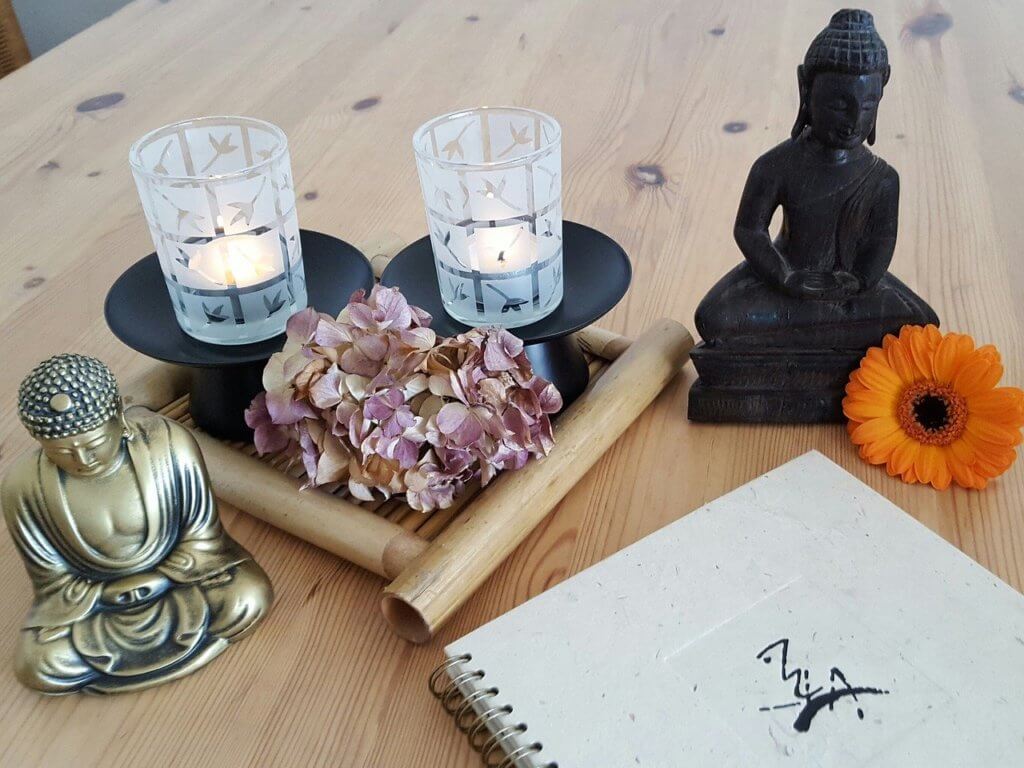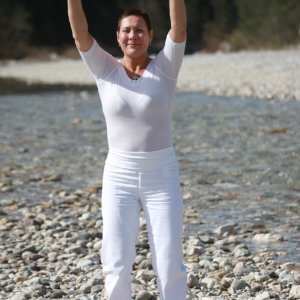
Chi - Kung as a method of health care
 21. 05. 2020
21. 05. 2020

One way to take care of your health is to exercise regularly. Most of us have already tried yoga, tai chi, jogging, classic running and much more. Today we will introduce you to the not very well-known method of practicing Chi-Kung, which is considered to be a prevention against diseases of civilization.
Chi - kung developed on the basis of the meridian theory of traditional Chinese medicine.
Meridians are energy, or acupuncture, pathways that create a closed energy cycle of the human body. Each meridian bears the name of a specific functional group, which is represented by either a "yang" (hollow) or a "ying" (full) internal organ. There are 12 regular tracks and 8 special tracks.
The twelve proper pathways are the meridians of the lungs, colon, stomach, spleen, heart, small intestine, bladder, kidneys, pericardium, three emitters, liver and gallbladder. The eight special pathways are the meridians of conception, control, central, belt, yin heel, yang heel, yin binder and yang binder.
To understand the qigong exercises, the term "qi" and the term "kung" still need to be explained.
Chi is a Chinese term for air, steam or breath. When we talk about the inner parts of the body, then qi means breath. In military terminology, qi is associated with the meaning of energy, vitality and life force. The word kung can be interpreted as effort. The combination of the words "qigong" then means the conscious and continuous development of life energy.
The origin of qigong practice can be dated several hundred years BC. There are written codes, rules, and theories of qigong.
The goal of a person who practices qigong practice is to control his breath, or his qi, so that it flows freely through the twelve main meridians. Traditional Chinese medicine assumes that health is the result of the harmonious flow of qi throughout the body.

Diseases are the result of an imbalance of qi, or its uneven flow through the twelve major meridians.
Meridian heart
The path leads from the end of the big toe on its inner side, through the inner ankle, along the tibia through the knee, thigh, groin, penetrates into the abdomen and connects with the spleen. The right branch corresponds to the pancreas and the left to the spleen. It then leads through the junction to the stomach, passes through the diaphragm to the esophagus, joins the root of the tongue and disperses beneath it. Its branch separates from the stomach, leads through the diaphragm and flows into the heart.
Lung meridian
It starts inside the torso in the area of the central radiator, from there it leads down towards the large intestine, then back along the stomach, from the portal to the gastric entrance, penetrates the diaphragm and enters the lungs. From the lungs it continues up to the trachea and throat. From the throat, it extends transversely to the armpit and continues along the inside of the hand to the tip of the thumb, where it ends. The path of the lungs has one branch, which separates approximately behind the wrist and continues along the edge of the index finger to the inner edge of the base of the nail bed, the 1st point of the path of the large intestine. This branch crosses the path of the large intestine.
Stomach meridian
Yang track, descending from head to toe. It starts on the 2nd, 3rd and 4th toes, on the instep these three stripes join and continue up in two branches. On the lower jaw, it branches again in three directions. One branch goes up over the face to the inner corner of the eye and to the side of the nose, while from this branch there are three more short branches to the upper lip and under the lower lip.
Colon meridian
The yang path runs upwards from hand to head. From the inner edge of the nail bed, it leads the index finger along the edge of the forearm over the outside of the biceps muscle to the shoulder. From the shoulder, it branches over the trapezius muscle to the seventh vertebra and returns to the collarbone cavity, triggering a branch into the lungs to the large intestine. From the hole, the second branch goes through the throat to the lower teeth, bypasses the mouth and ends next to the nostrils of the nose. The meridian, which goes from the right side, ends on the left side of the nose and vice versa. One branch separates at the point pchien-li, which is a branch on the forearm into the path of the lungs, the other branch from there goes along the path of the large intestine to the ear.
Small bowel meridian
Yang track running upwards from hand to head. It starts on the outside of the tip of the little finger, goes along the underside of the elbow to the back of the shoulder through the shoulder blade under the 7th cervical vertebra. From there it goes forward to the hole above the collarbone, where it branches in two directions. It leads down through the line to the heart, stomach and small intestine, up the side of the throat to the outer corner of the eye and then enters the ear. From the sled, a short branch branches off to the inner corner of the eye, where it connects with the bladder path.
Spleen meridian
The path leads from the end of the big toe on its inner side, through the inner ankle, along the tibia through the knee, thigh, groin, penetrates into the abdomen and connects with the spleen. The right branch corresponds to the pancreas and the left to the spleen. It then leads through the junction to the stomach, passes through the diaphragm to the esophagus, joins the root of the tongue and disperses beneath it. Its branch separates from the stomach, leads through the diaphragm and flows into the heart.
Meridian gallbladder
From the outer corner of the eye it rises in arches to the top of the head, descends into the space behind the ear, continues along the side of the neck to the shoulder, to the hole above the collarbone and the side of the torso leads down to the toe. From the corner of the eye, a new branch is lowered to the lower jaw, it connects with the path of the three emitters and returns to the eye via the cheekbone. The course of the whole course is complicated.
Kidney meridian
It begins below the little finger and progresses obliquely in the middle of the arch of the foot, around the inner ankle upwards with the inner side of the calf, over the knees and thighs, penetrating the spine, connecting to the kidneys and through the junction with the bladder. Its straight path emerges from the kidneys upwards, penetrates the liver and diaphragm, penetrates the lungs, advances along the throat and grips the root of the tongue. Its next branch comes out of the lungs, leads through the line to the heart and gathers in the middle of the chest.
Liver meridian
A yin path running upwards from the base of the thumb nail, over the instep, the inner ankle, crosses the path of the spleen above it and proceeds along it along the inside of the calf and thigh to the groin, where it wraps around the external genitals. It leads over the underside of the abdomen, turning to the side under the free ribs. The next section has connections to the stomach, liver and gallbladder. This is probably an internal branch. From the liver, it continues through the inner side of the torso through the diaphragm and lower ribs to the throat, behind the pharynx it penetrates into the nasal cavity, through it to the optic nerves. It proceeds to the top of the head, where it connects with the control channel. From the optic nerves, one twig of the path points to the corners of the mouth and wraps the lips from the inside. The last short branch emerges from the liver, penetrates the diaphragm and disperses into the lungs; according to some sources, however, it continues to the area of the stomach and middle radiator.
Heartburn meridian
A yin track running downhill from the chest to the arm. It starts in the middle of the chest, passes through the pericardium, descends through the diaphragm and connects three radiators. Its superficial branch goes from the center of the chest through the nipple to the armpit and from there it descends down the inside of the hand through the palm to the end of the middle finger. It has a small branch from the center of the palm, which ends at the end of the ring.
JIN - JANG
However, when practicing qigong, it is also necessary to understand the characteristics of "yin" and "yang" of all four seasons and to plan one's practice accordingly. Spring and summer are warm seasons and therefore support yang. Autumn and winter are cold and windy and therefore support yin. Chi-kung exercises can be divided into two general categories:
Way-tan (external elixir) - this practice increases the circulation of qi. By stimulating one area of the body - the limbs - we create a large potential of energy so that it flows through a system of qi channels from places with lower potential. It uses the self-regulatory abilities of the organism. The advantage is that to effectively practice waj-tan exercises, we do not need to have extensive knowledge of the energy system and its laws.
No-tan (inner elixir) - it is the accumulation of qi internally, in the body and then it is led out into the limbs. Non-tan exercises are highly valued for their effectiveness and virtually unlimited range of uses. In order to practice non-tan exercises properly, we need to already have some knowledge about the functioning of the energy system (heaven-earth-man). Therefore, it is recommended to have professional guidance for their implementation.
Chi-kung is roughly divided according to its focus and the ultimate goal of the exercise.
Maintaining health - health prevention, harmonization, maintaining a high level of qi, the emphasis is on the regularity of exercise, daily work on oneself.
Treatment of diseases - targeted exercises to eliminate even large disharmonies in the body, large numbers of repetitions of specifically focused exercises are practiced.
Martial Arts - targeted use to increase the fighting abilities, defenses and resilience of the trainee's energy system.
How to start exercising
Learning to perceive the breath - qi, or to perceive energy and then work with it is quite simple. The description of the exercises in the books is often complicated, and you may have tried similar exercises without much success in tai chi courses. And you may not even be so convinced of the existence of this energy. Surprisingly, for a start, it is enough to perform individual exercises. The implementation itself is surprisingly simple. However, if you want to know the essence of the exercises and their principle, it is good to attend a qigong exercise course. For a complete start, just take a weekend course to get an idea of the right exercise.
If you want to try the exercise now, we bring you a brief guide.
Shaking the body
First, the whole body must be relaxed. Spread your feet shoulder-width apart and relax your shoulders and arms. Start swinging on your toes, lifting your heels about 1-1,5 cm high. With each impact of the stalemate, imagine "polluted qi" leaving your body into the ground. Run the exercise for about three minutes. You can continue by raising your arms to the sides with your palms facing up. Try to imagine that your arms reach high to infinity. Take a deep breath and take the surrounding qi into the space between your arms, which you hold above your head. Imagine your body as an empty vessel, to the top of which - which is your head at the moment - you pick up fresh qi and push the bad qi out of your body into the ground. Repeat the whole exercise several times.

Chi - kung in motion
Relax the whole body again, straighten the spine and concentrate your attention and thinking completely inside you. Imagine that your head is light, upright and as if suspended by a string lowered from the sky. Look straight. Slightly lower your hips and then start rocking your feet and toes. This activates the points on the feet and revives qi in the canals of the legs. This improves kidney and urinary system function. Start walking evenly and easily on the spot, while imagining the energy flowing upside down into your spine to the top of your head, then arching back in front of your body into your toes and hitting the ground.
Chi-kung lying down
This exercise balances blood pressure. Lie on your back, close your eyes and relax. Extend your hands along your body with your palms down. Inhale again over the top of your head and then exhale and imagine the inhaled qi flowing through your body to your feet. Exercises performed in this way are suitable for people with high blood pressure. For people suffering from low blood pressure, this exercise is adapted. Lying down, stretch your arms along your body but with your palms up. Inhale through the points on the feet and exhale through the head. However, do not focus on any of the points too hard. You can also fall asleep calmly during this exercise.
Chi kung for better sleep
Relax and lie on your back and place your palms just below your navel, about two or three fingers apart. Next, imagine that there is a warm, red ball inside your body under your palms. Fall asleep with this idea. You can also lie down on your side and support your head with your hand and place your other arm on the same point. Sleep like this.
Keep in mind that qi movement is driven by your mind. Your qi travels through the mind to where we need it. The mind and qi are connected into one whole. There is no place on the body where qi does not get. If we elevate our spirit, then we can control our body with the help of qi.
Tips from the Sueneé Universe e-shop
Věra Sedlářová: Rare Encounters - Dreams with You
Dreams show us the way and offers problem solvingthat bother us in our lives. Learn to understand and perceive yours sny and get rid of unresolved issues with their help, purify your karma.






 6
6